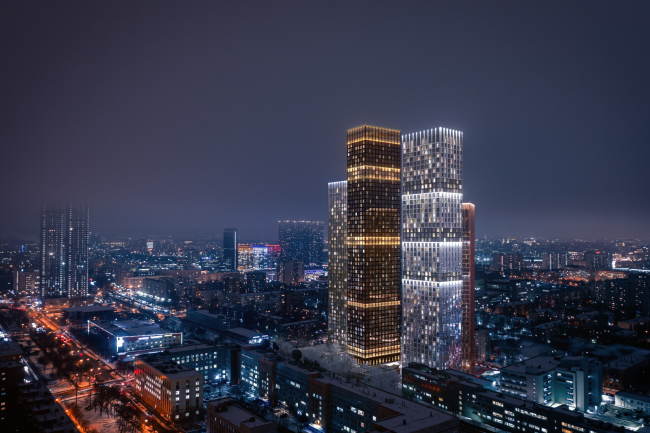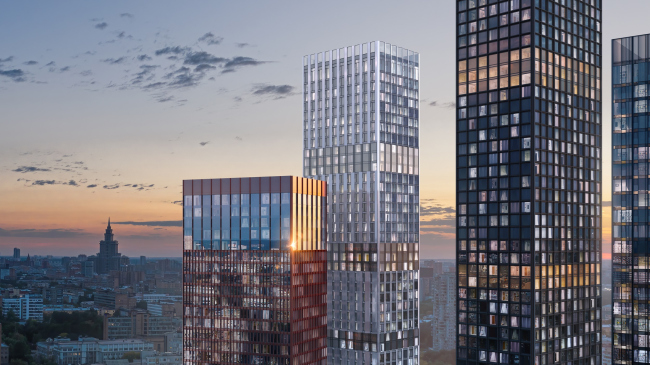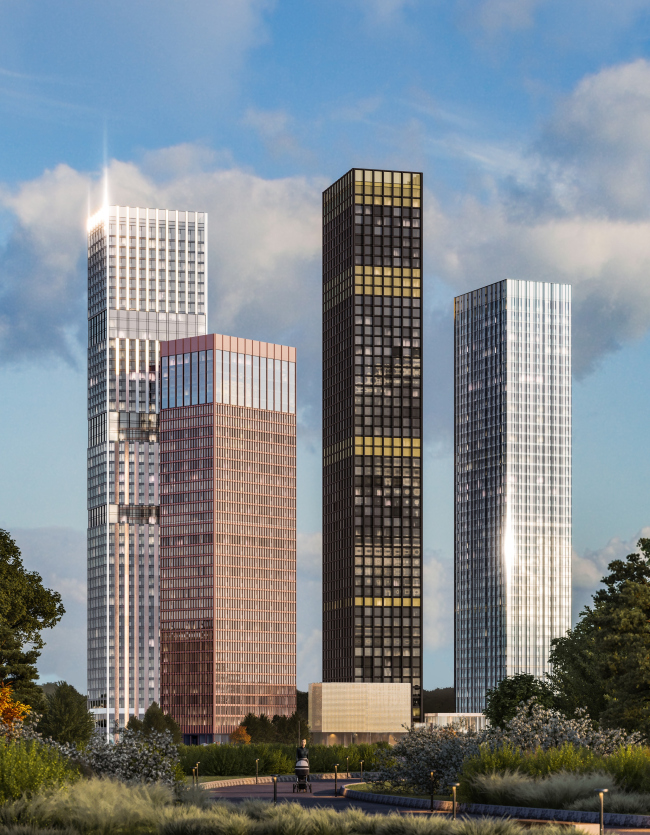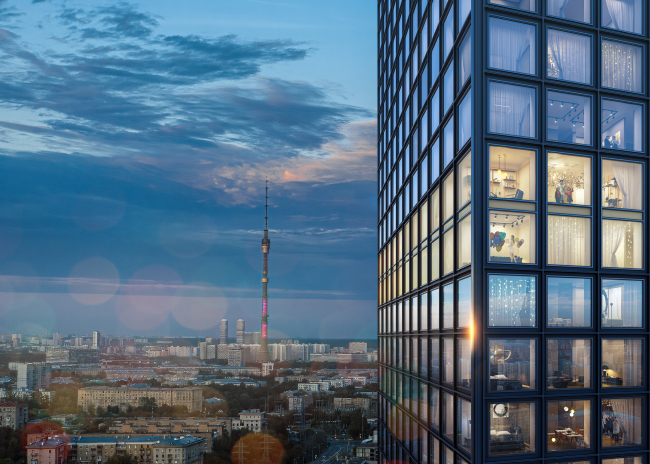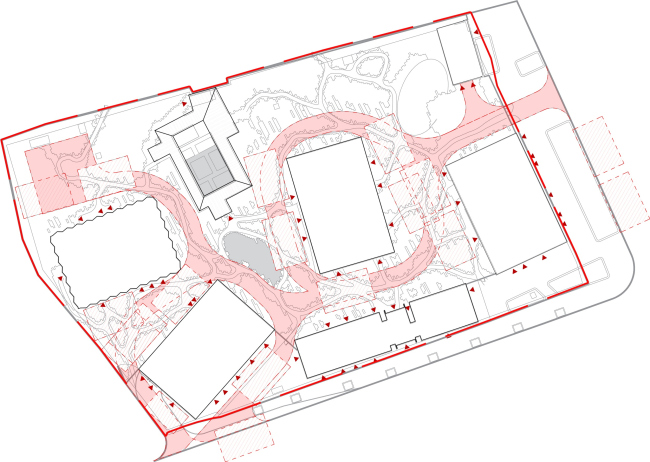|
Published on Archi.ru (https://archi.ru) |
|
| 08.02.2021 | |
|
The Energy Family |
|
|
Alla Pavlikova, Arina Strigova |
|
| Architect: | |
| Sergey Pereslegin | |
| Nikolay Pereslegin | |
| Georgy Trofimov | |
| Studio: | |
| Kleinewelt Architekten | |
|
The housing complex Symphony 34 will be built in Moscow’s Savelovsky district; it will consist of four towers from 36 to 54 stories high. Each of the towers has an image of its own, but they all are gathered into a single architectural ensemble – a fragment of a new high-rise urban space lying outside the Third Transport Ring. The project of the high-rise housing complex Symphony 34 was developed by Kleinewelt Àrchitekten at the commission from MR Group. Its land site, small, 1.4 hectares, is situated in the north of Moscow, near Dmitrovskaya metro station, not far away from two other high-rise housing projects commissioned by the same developer: D1, designed by Kamen Architects, which is being finished mere 500 meters east of the metro station, and Savelovsky City, designed by SPEECH, which is plainly seen a bit farther away, behind the Dmitro Highway. Savelovsky was designed in the early 2010’s, the height of its buildings being 155m; D1 appeared a little bit later, in 2018, the height of its tallest tower being 191m. The new complex maintains the “growth trend” in the string of the residential skyscrapers, the topmost mark of its “main” tower being 190m. According to the architects, the town planning significance of the new high-rise project is that it “throws a visual bridge” from the already mentioned skyscrapers of Moscow’s north to the west, towards the high-rises of Leningrad Avenue. At the same time, in the East, in the distance, the string of high-rises is continued by the Ostankino TV tower and the 192-meter-high housing complex Tricolor. Symphony 34 housing complexCopyright: © Kleinewelt ArchitektenSymphony 34 housing complexCopyright: © Kleinewelt ArchitektenSymphony 34 is one of the most recent high-rise projects of MR Group: the closed-door competition, which involved three architectural companies, took place in March 2020. Kleinewelt Àrchitekten won the competition and immediately got down working on the project. The team of Sergey and Nikolai Pereslegins and George Trofimov offered the developer several versions of the future complex. As the chief architect of the project Xenia Vorobyeva shared, in all of the versions the architects aimed at creating a wow-effect by finding flashy solutions. Eventually, the developer opted for the version, which, as Xenia shares, the architects themselves liked best of all – the one with buildings of different height and expressive design of the facades. Symphony 34 housing complexCopyright: © Kleinewelt ArchitektenThe architects had a task of forming a full-fledged living environment with a developed urban infrastructure, thoroughly organized yard space, extra public functions, and, of course, great views of the city. The towers will command panoramas of the Moscow City business center, Timiryazevsky park, and Ostankino TV tower. Symphony 34 housing complexCopyright: © Kleinewelt ArchitektenThe land site is situated next to the D2 line of Moscow Central High-Speed Diameter, which separates Savelovsky and Timiryazevsky districts; the Dmitrovskaya station of Moscow Central High-Speed Diameter will also be the closest entrance to the metro. Currently, the site is a small piece of industrial warehouse estate, the kind that usually alternates here with quite self-sufficient blocks of five-story houses. The arrangement of the four towers that make up Symphony 34 was conditioned by the proximity of the railroad line, views from the windows, but, above all, by the insolation requirements. According to Xenia Vorobyeva, the architects spent a lot of time moving the volumes and spinning them around their axes in order to let as much natural light as possible into the apartments – it was the insolation that determined the delicate turns of the towers in respect to one another, and their slight “waltzing” around the central Building A, the main high-rise centerpiece, proudly standing almost in the very center of the site. Symphony 34 housing complex. The fire planCopyright: © Kleinewelt ArchitektenAs is known, making a composition of four towers is more difficult than two or three. Kleinewelt Àrchitekten took the path of the optimum balance of unity and diversity: the plans of all the buildings are based on the common column pitch of 3.3m, also reflected in the common “square” façade module. The unity is also enhanced by the materials – aluminum and glass (the apartment windows are no less than 2.1m high). The base spot of each tower is also of the same size. However, despite the unity of the mentioned parameters, each tower is endowed with a clear individual imagery: the color, the façade design, and the height of the towers are different. Hence, it comes as no surprise that all the four buildings got poetic names. The architects emphasize that the complex will look really different when viewed from different vantage points, dynamically changing its silhouette, composition, and combinations of color accents. The tallest Tower A has 54 floors in it, its height – 190m – meeting the height restrictions of the site. The tower was named Graphite after its pitch-black aluminum facets of the floor-by-floor panoramic stained glass windows 2.6x2.6m. The black color of the faceting pattern is echoed by polarized glass (whose tint, of course, works only on the outside, without blacking out the interiors of the apartments). The tallest tower, placed, as we remember, in the center of the composition, looks like a gigantic “graphic rod”, figuratively conveying the common words that skyscrapers both reflect and form the energy of a megalopolis. The four towers are as good as a nuclear power plant that generates the big city drive and processes its energy at the same time. The black skyscraper becomes a figurative paraphrase of the nuclear reactor graphite rod, the “moderator” of the city energy – visual in this specific case. At the same time, “sparks” are definitely flowing around it, and it does attract attention: by any standards, a tower is a pretty bold statement. 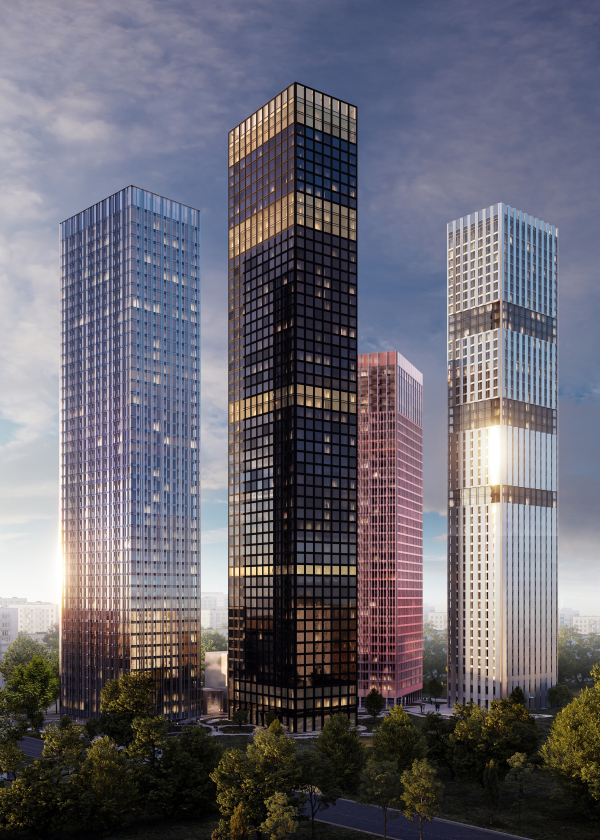 Symphony 34 housing complexCopyright: © Kleinewelt Architekten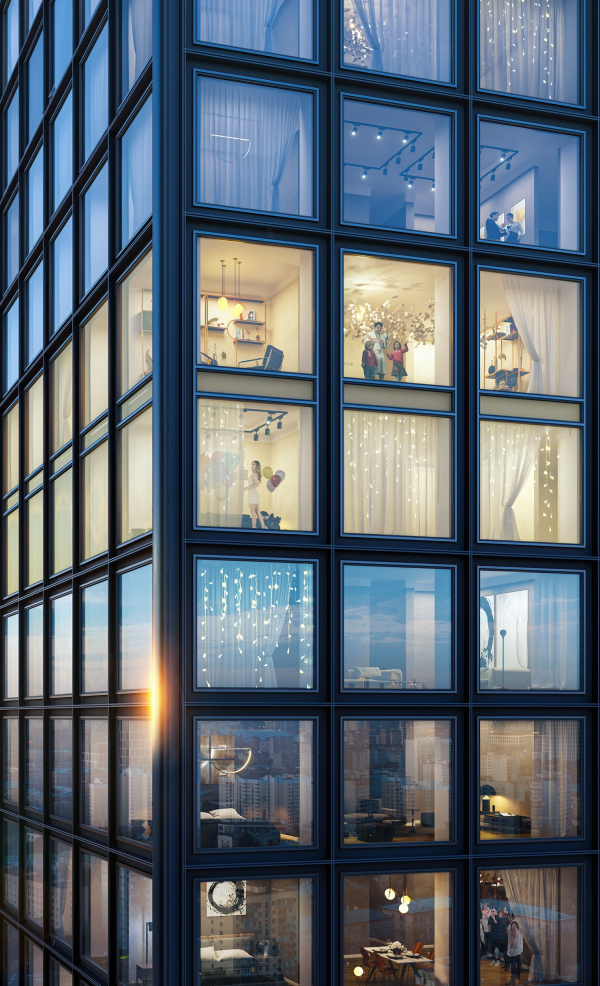 Symphony 34 housing complexCopyright: © Kleinewelt ArchitektenThe tower is not completely black, however. In addition to the fact that the piers are livened up by a pattern of thin gray stripes, instead of the dark stained glass, some of the windows got transparent glass with a yellow tint. These light-colored windows form bands of varying width: two, one, two, three, and, finally, four floors up in the attic. The bands divide the skyscraper into unequal parts, playing with the scale; they look, particularly in the nighttime lighting, like some golden rings on a black glove, or maybe flames of pure energy running up and down the graphite core – which looks solemn and at the same time bold, just the way it should be with the main highlight. In a word, it is obvious that the black tower plays the first violin in this orchestra. The second tallest tower, 49 stories high, is called Crystal. It is situated west of the center, and is turned to the central skyscraper at a 90-degree angle. It looks as though it was contradicting the main tower in every conceivable respect: while the black volume is smooth, Crystal is light and has a lot of ribs – yet at the same time it also looks like the main building’s Alter Ego in terms of height and the smooth glass “belts”, which also divide the volume into a few unequal parts, albeit in different proportions. Groups of towers are often described in “family” categories, such as “sister towers” or “spouse towers”, but, if you look from this side, the graphite and the crystal skyscrapers are, of course, mom and dad, or even yin and yang. At the same time, however, it would be hard to say which of the volumes the female one is: according to the Far East logic, it must be the black tower, but the European cultural tradition prompts us to consider the taller and the more austere volume to be the male one. However, no one insists on an uncompromising reading of the associative series in this case. The volume of Crystal is elegant and silvery; it is composed of triangular bay windows, one half being tinted glass in the part between the floors, the other half being metallic surface. The bay windows are turned in such a way as to command the best views and let in as much as possible natural light. Everything works towards creating a “crystal” image with a multitude of facets and glitter of reflected light –and at the same time it all looks like a neat modernist pleating. 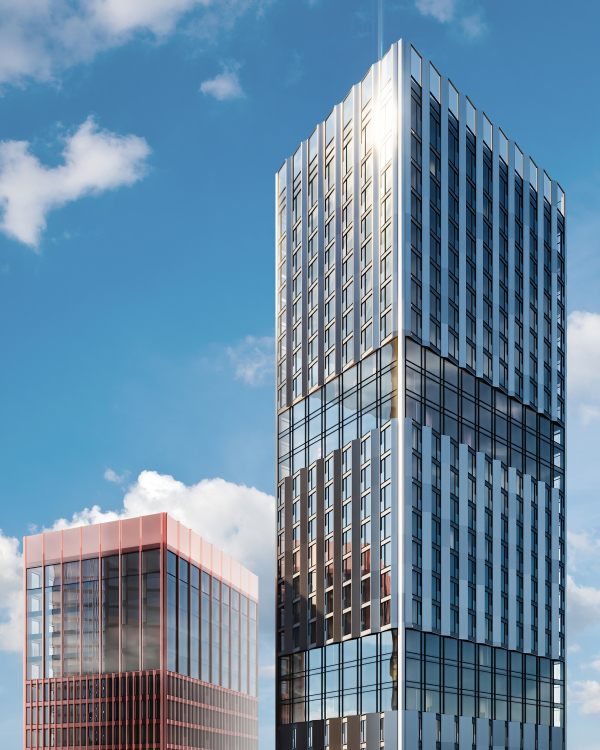 Symphony 34 housing complexCopyright: © Kleinewelt Architekten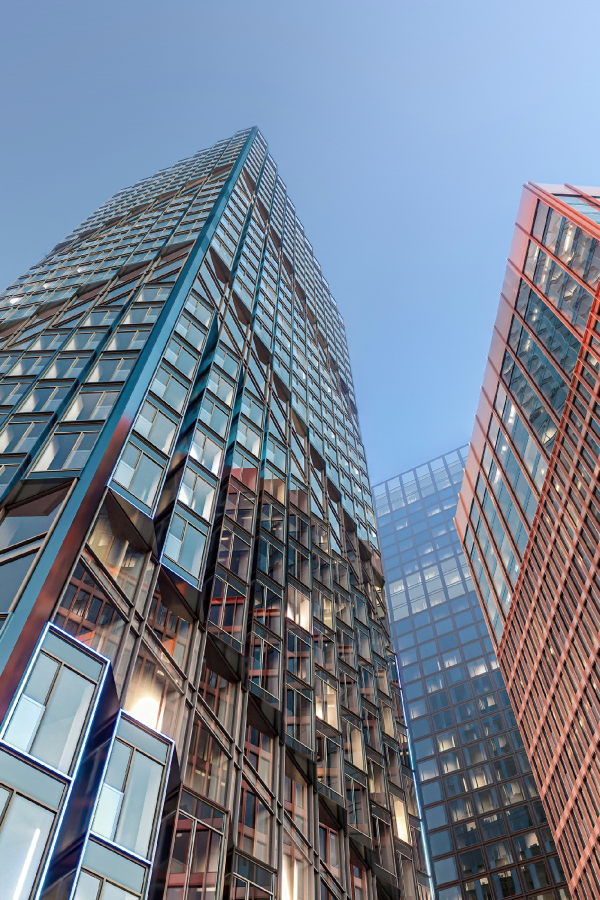 Symphony 34 housing complexCopyright: © Kleinewelt ArchitektenThe two other towers of a smaller height could be interpreted as children of this imposing couple – not as babies but rather as teenagers. Tower C, called Silver – a 43-story volume in the eastern part – responds to the Crystal high-rise. It is the closest of all to the search of “classic modernism”: glass facades and thin aluminum molds running over the glass accentuate the vertical and make the surface glitter in the slanting rays of the setting sun. From a distance, it must look like a satin surface of polished metal. The difference from modernism is obvious: the stripes are unevenly distributed, sometimes thicker, sometimes thinner. The smallest of the four towers – the copper 36-story tower D Siena – is rotated at a 45-degree angle, facing the brick block buildings, with which it echoes with a reddish hue, which can well be compared with Terra di Siena, explaining the name of the building. 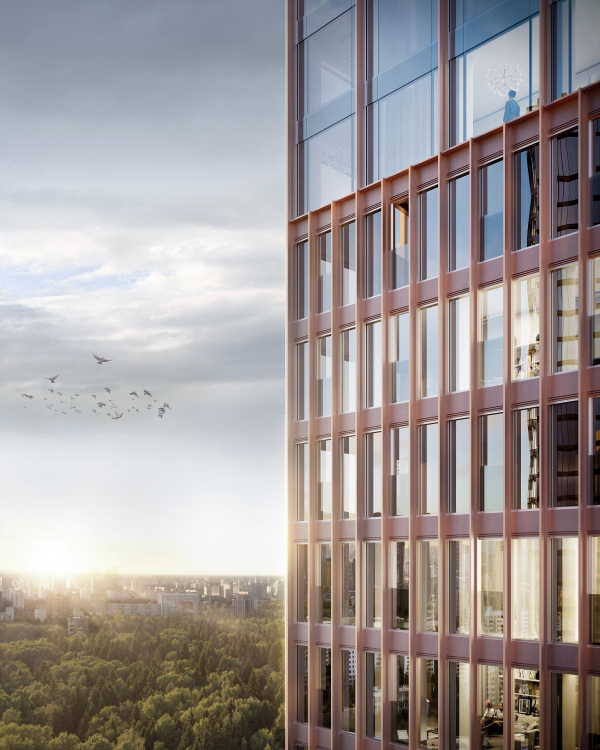 Symphony 34 housing complexCopyright: © Kleinewelt Architekten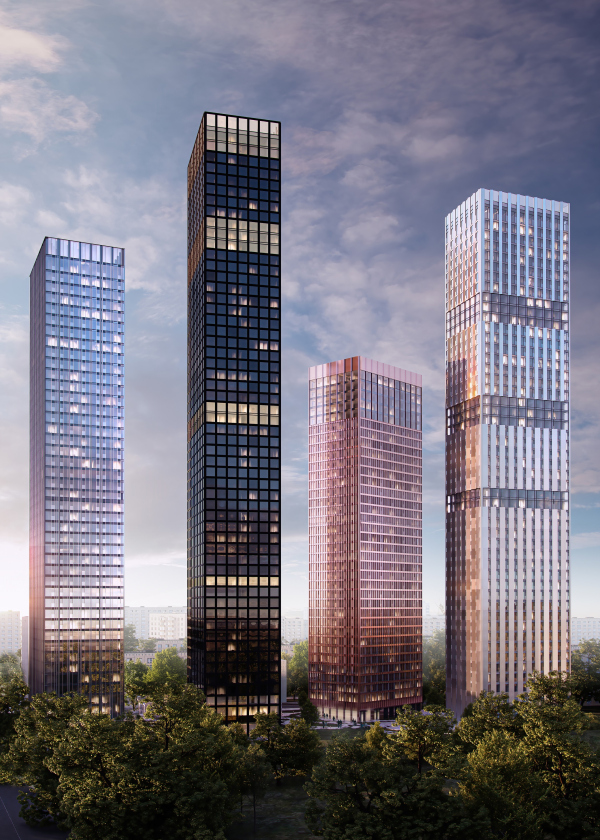 Symphony 34 housing complexCopyright: © Kleinewelt ArchitektenBut then again, on the facades the architects are planning to use aluminum the color of polished copper, while the modular squares of the windows are divided here by thin lamellas into three equal parts, which generally also accentuates the vertical, only this time without asymmetric livening up of the rhythm, as in the previous tower. The top five floors of the sienna copper tower do not have the vertical lamellas – they form a glass attic belt, responding to the design solutions of the high-rise “parent” towers. 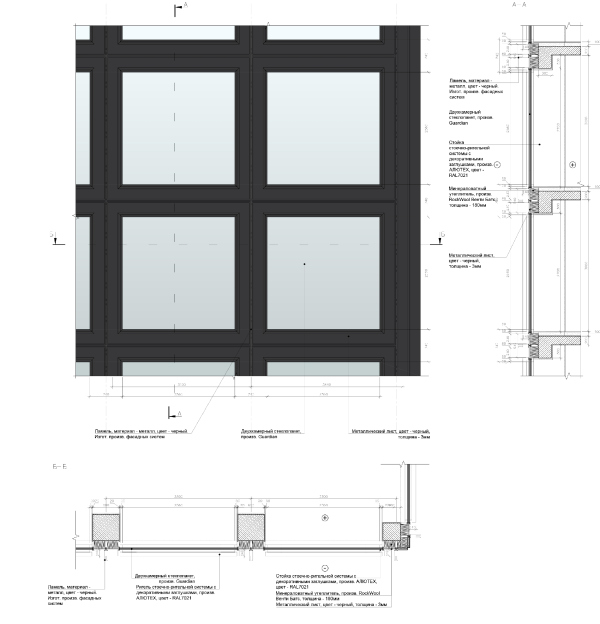 Symphony 34 housing complex. Tower A. FacadeCopyright: © Kleinewelt Architekten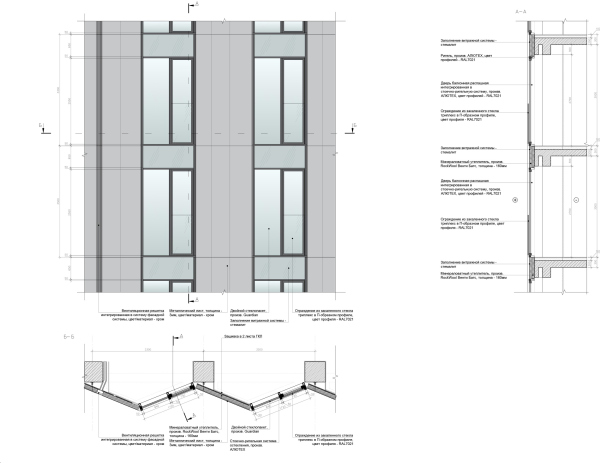 Symphony 34 housing complex. Tower B. FacadeCopyright: © Kleinewelt Architekten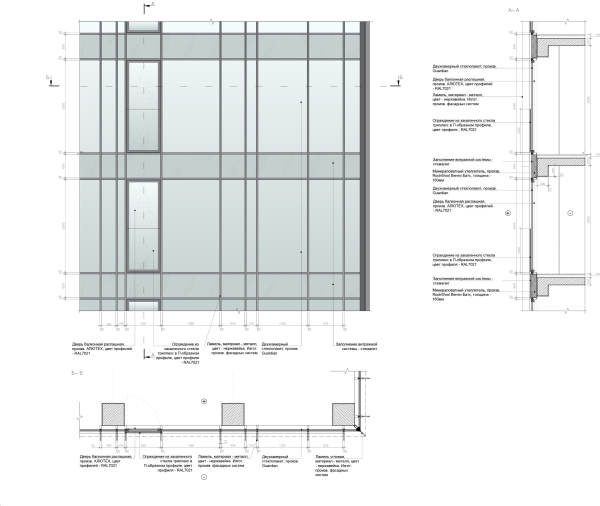 Symphony 34 housing complex. Tower C. FacadeCopyright: © Kleinewelt Architekten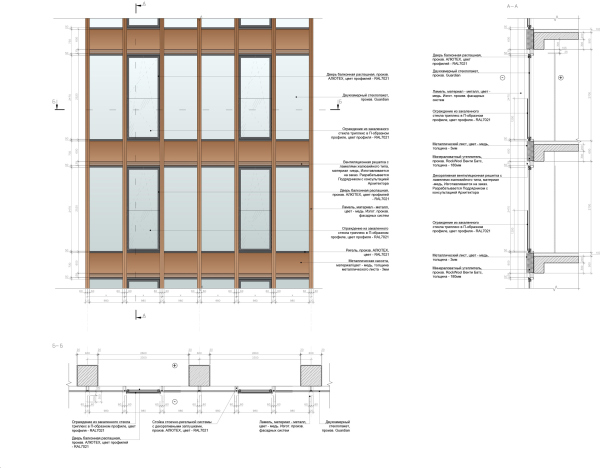 Symphony 34 housing complex. Tower D. FacadeCopyright: © Kleinewelt Architekten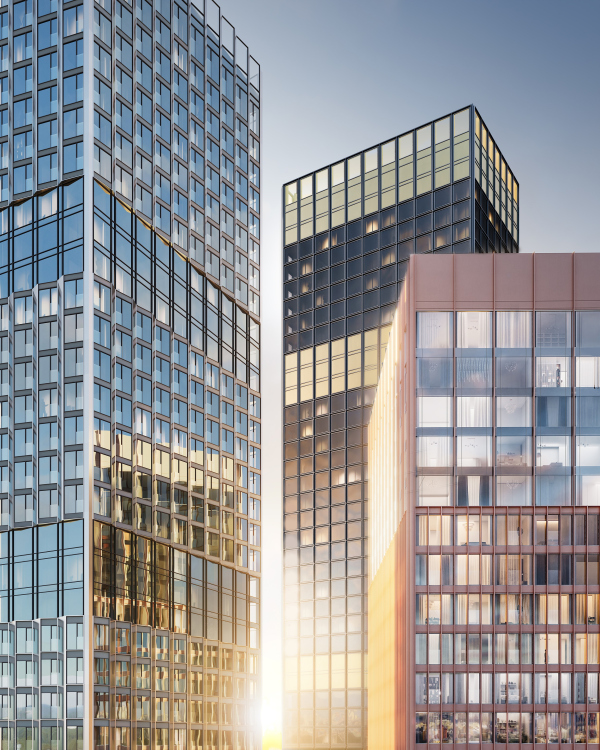 Symphony 34 housing complexCopyright: © Kleinewelt ArchitektenThe main rhythmic ideas of the towers – so similar and so different – were reflected by the architects in an image that can deservedly become the logo of the complex. 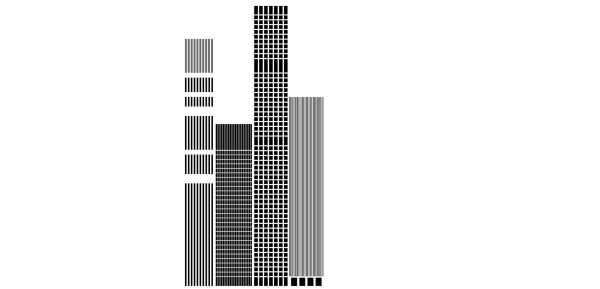 Symphony 34 housing complexCopyright: © Kleinewelt Architekten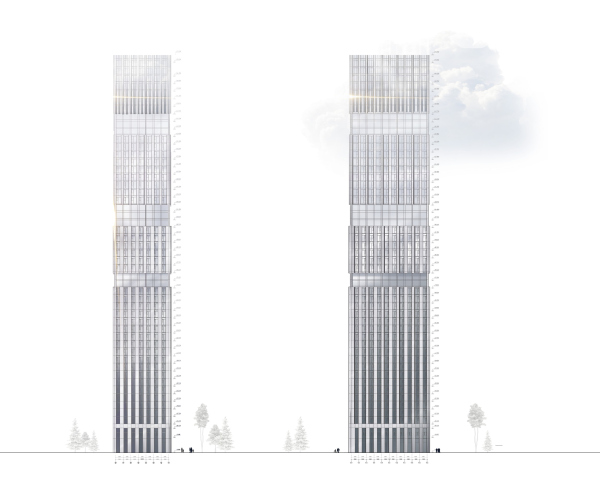 Symphony 34 housing complex. Tower B. FacadeCopyright: © Kleinewelt Architekten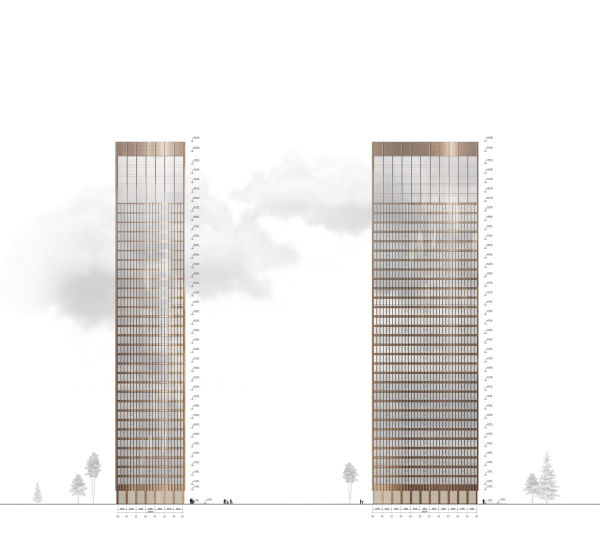 Symphony 34 housing complex. Tower D. FacadesCopyright: © Kleinewelt Architekten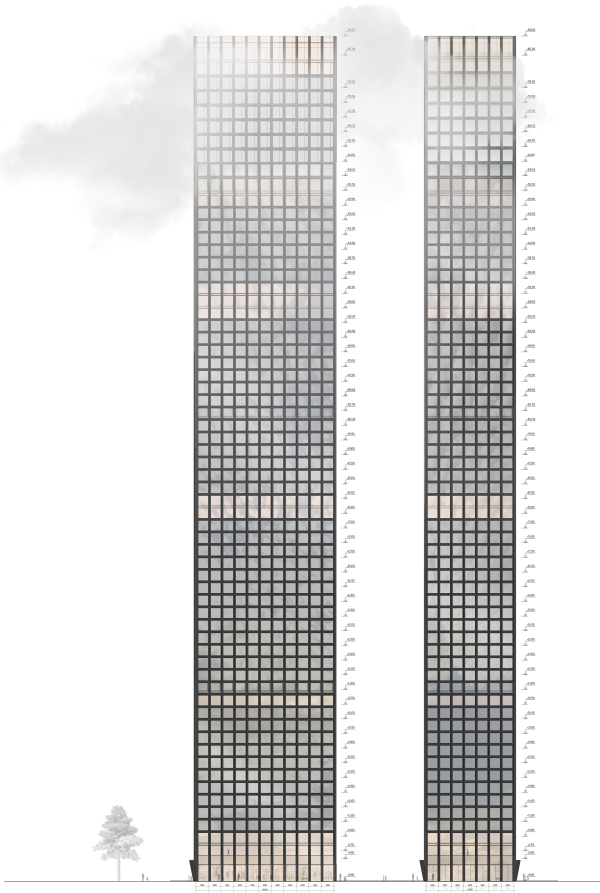 Symphony 34 housing complex. Tower A. FacadesCopyright: © Kleinewelt Architekten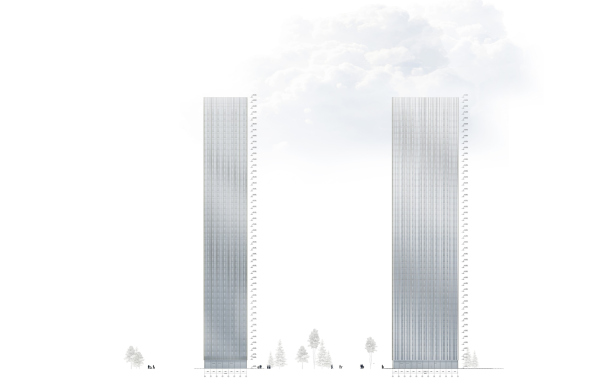 Symphony 34 housing complex. Tower C. FacadesCopyright: © Kleinewelt ArchitektenAnd the complex also has a “baby” building in it – an elongated two-story volume of a fitness club and a restaurant, which stretched along the 2md Khutorskaya Street. It serves as the main entrance area to the territory of the complex, which the architects are planning to turn into a park ensemble with a large number of grown-up trees. The yard has a minor difference in relief, about 2m, rising up to the north. This will help to create an extra natural border between the yard and the railway line. 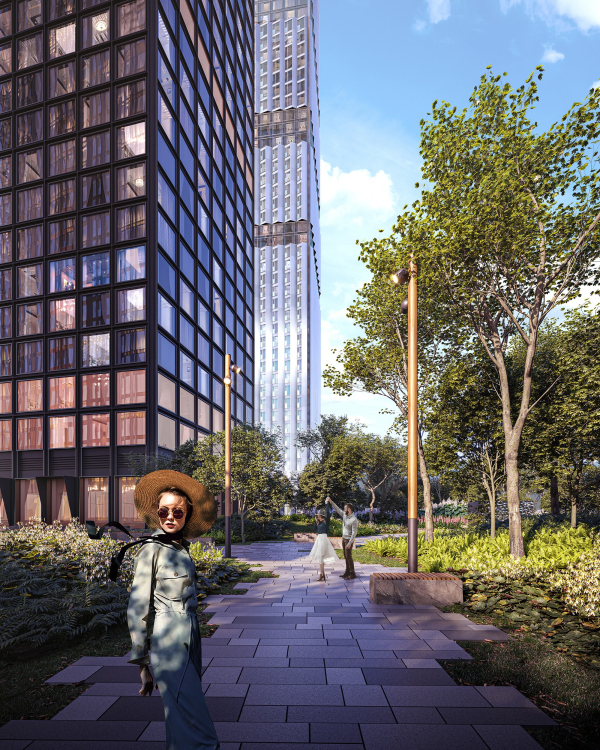 Symphony 34 housing complexCopyright: © Kleinewelt Architekten Symphony 34 housing complexCopyright: © Kleinewelt ArchitektenThe buildings will feature all types of apartments, ranging from studios to four-room apartments, as well as penthouses from 129 to 162 meters square, which will occupy the top floors in three towers – on the 54th, 49th, 43rd floors. The bottom floors will host retail. There will also be a two-level underground parking garage. Symphony 34 housing complex. Plans of the towers A, B, CCopyright: © Kleinewelt ArchitektenThe complex was named in honor of the famous symphony by Mozart. The polyphony and richness of the sound of Mozart’s symphony inspired the architects to create this grand-scale project. Each building here has a unique “voice” of its own; each volume contains a gamut of emotions. Different in appearance and in character, they are nonetheless, resonant with one another and with the city. The project has already received expert approval. The completion of its implementation is scheduled for 2024. |
|
